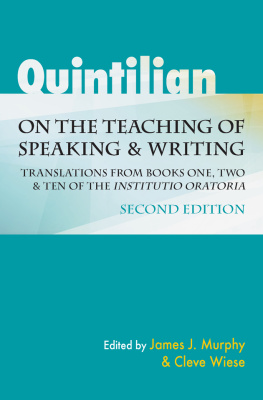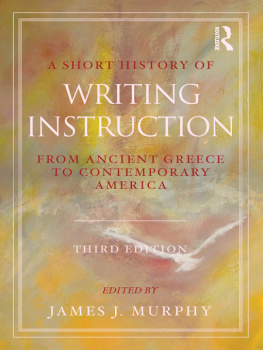Quintilian, author.
[Institutiones oratoriae. Selections. English]
Quintilian on the teaching of speaking and writing : translations from books one, two, and ten of the Institutio Oratoria / edited by James J. Murphy and Cleve Wiese. Second edition.
pages cm (Landmarks in rhetoric and public address)
Summary: Translation, with introductory material and other critical apparatus, of Institutio oratoria (The Education of the Orator), by Roman rhetor Quintilian (Marcus Fabius Quintilanus, ca. A.D. 3598?). Provided by publisher.
Includes bibliographical references and index.
ISBN 978-0-8093-3440-7 (paperback)
ISBN 978-0-8093-3441-4 (e-book)
1. OratoryEarly works to 1800. 2. RhetoricEarly works to 1800.
I. Murphy, James Jerome, editor. II. Wiese, Cleve, editor. III. Title.
Printed on recycled paper. 
The paper used in this publication meets the minimum requirements of American National Standard for Information SciencesPermanence of Paper for Printed Library Materials, ANSI Z39.48-1992. 
PREFACE
This is a book about how a lesson once learned can be used again.
It is also a book about future writing and speaking, about preparing for discourse that is yet to be.
It takes advantage of the longest-lasting teaching process in Western civilization, which was devised by Roman schoolmasters more than a century before the birth of Christ. Over the next two thousand years, this teaching process influenced figures as diverse as Cicero, Saint Jerome, Erasmus, Martin Luther, John Milton, John Stuart Mill, Winston Churchill, and John F. Kennedy. The Roman schools prepared a carefully crafted learning sequence based on a close relationship between the four factors of listening, reading, speaking, and writing.
Toward the end of the first Christian century, the best features of this system were distilled into a comprehensive work titled Institutio oratoria (The Education of the Orator). The author was Marcus Fabius Quintilianus (circa A.D. 3598), one of Romes most famous teachers, who had flourished under three emperors and then devoted two years of his retirement to describing and explaining his educational program.
This volume offers translations from the three key sections of the Institutio oratoria in which Quintilian provides the rationale for an education that looks to future writing and speaking.
Modern readers, it is hoped, will find his ideas as useful today as they have been in many countries for nearly two thousand years.
PART ONE
THE DIDACTIC PHASE: LEARNING ABOUT QUINTILIAN
This phase acquaints the reader with Quintilian, his place in history, and the main principles of his educational program for the promotion of literacy.
Quintilian in the History of Western Education
In one sense this is the story of a centuries-old successful approach to the teaching of speaking and writing, and in another sense it is the story of the one ancient book that best typifies that approach.
To understand the story, we have to start at the beginning.
The Concept of School
What became Roman education began, as did so much of Roman culture, in ancient Greece. Democratic education in ancient Greece was necessarily of a collective character because it aimed to provide learning opportunities to all free men. This goal led to the creation and development of a remarkable social toolthe school. It is often difficult for the modern student and the general public to understand that the concept of school had to be invented. But it was a deliberate cultural choice at a certain stage in Western civilization, one that has dominated our subsequent thinking.
Yet there have always been alternatives. It has always been possible for the rich or the reclusive to hire a tutor for a son or a daughter, and on the other hand, for the ignorant or the religious zealot to reject any learning at all. At the level of trades like carpentry or masonry, one-on-one apprenticeships have long been popular. Overthe centuries the predominant choice of societies as diverse as the Roman Empire and Christian monasticism has been, nevertheless, to gather young people in groups to receive purposeful instruction in the methods and values dear to those societies.
For the Greeks, and for the Romans who inherited Greek thought, such instruction usually began with the matter that made all other learning possiblethat is, it began with language and the uses of language. The interplay of speaking and writing has been an integral part of this instruction from the beginning.
These are historical truisms of Western culture, but they are worth repeating here because they illustrate the central importance of Quintilians concerns. Quintilian not only describes for us the educational processes that he inherited and that were to be replicated substantially down into our own century, but he also explains to us why these processes are superior to their alternatives and what they can accomplish for society by educating citizens who are both humane and effective. His frequent discussions of alternative ideas provide us with a depth of understanding that could not be reached by a bare statement of a single viewpoint. That is why you need to read Quintilians own words in these translations rather than trusting someone elses summariesincluding our own.
The Romans were a systematic people. Their remarkable feats of hydraulic engineering created aqueducts for the water supply of cities. They built paved roads that, in some parts of the world, are still usable today. The Romans introduced central heating for buildings. They pioneered the mass production of chariots and naval vessels with interchangeable parts to support a carefully designed military force that dominated Europe, Asia Minor, and North Africa for five hundred years. The governmental structure of the Republic was delicately balanced to prevent any one man from seizing absolute power, with paired executives (the consuls), a parliamentary body (the senate), and representatives of the people (the tribunes) having the power of veto; this pattern of government worked so well, in fact, that when the Republic finally succumbed to personal dictatorships it was possible, even then, for the emperors to keep the old mechanisms intact while they wielded the real power. The worldwide system of public administration under the empire was a marvel of meticulous record keeping. Inshort, the Romans were social engineers as well as mechanical and military experts.
It should not be surprising, then, to discover that the Roman approach to schools was equally systematic. We know that the subject of rhetoric was so highly schematized by the lifetime of Cicero (born 106 B.C.) that even as an adolescent (aged perhaps seventeen to nineteen) Cicero was able to rehearse what he had learned as a student to produce a major treatise on rhetorichis









